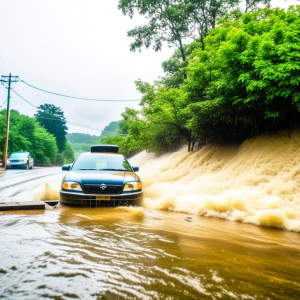Staying Safe During Flash Floods: Essential Information On Flood Alerts

Table of Contents
Understanding Flash Flood Alerts
Different alert systems exist to warn you about impending flash floods. Understanding these systems and their urgency levels is paramount.
Types of Alerts
Flash flood warnings and watches are disseminated through various channels:
- Weather Radio Alerts: NOAA Weather Radio provides 24/7 broadcasts of weather information, including flash flood warnings and watches. These alerts are often the earliest and most reliable source of information. Ensure your radio is properly tuned and equipped with battery backup.
- Mobile Phone Alerts: Many areas now utilize Wireless Emergency Alerts (WEA) to send flash flood warnings directly to cell phones. These alerts often include location-specific information and instructions.
- Local News Broadcasts: Television and radio news stations provide regular weather updates, including flash flood warnings and watches. Pay close attention to local news during periods of heavy rainfall or severe weather.
Urgency Levels:
- Flash Flood Watch: Conditions are favorable for flash flooding to develop. Remain alert and monitor weather conditions closely.
- Flash Flood Warning: Flash flooding is occurring or is imminent. Take immediate action to protect yourself and your property.
Terminology:
- Flash Flood Imminent: Flash flooding is expected to begin very soon.
- Areas Prone to Flash Flooding: Specific geographic locations are identified as having a high risk of flash flooding due to factors like topography and drainage.
Reliability and Limitations:
While alert systems are highly reliable, they are not foolproof. Factors like technological limitations and unexpected weather events can affect their accuracy. It's crucial to stay informed through multiple sources.
Checking Alerts:
- National Weather Service (NWS) Website: www.weather.gov provides up-to-date weather information, including flash flood alerts for your area.
- Local Emergency Management Agency: Your local emergency management agency website or social media channels offer localized alerts and instructions.
Preparing for a Flash Flood
Proactive preparation is key to minimizing risk during a flash flood. This includes developing a comprehensive family emergency plan.
Developing a Family Emergency Plan
Planning evacuation routes and establishing meeting points are crucial.
- Family Communication Plan: Designate an out-of-area contact person who family members can call to check in during and after a flash flood.
- Emergency Kit: Assemble a kit containing essential supplies: water (at least one gallon per person per day), non-perishable food, first-aid supplies, medications, flashlights, batteries, a portable radio, and important documents in a waterproof container.
- Safe Locations: Identify safe locations within your home (e.g., upper floors) and in your neighborhood (e.g., designated shelters).
- Securing Valuables: Move important documents, electronics, and other valuable items to higher ground.
Responding to a Flash Flood Alert
Timely and safe evacuation is critical when a flash flood warning is issued.
Evacuation Procedures
Heeding evacuation orders promptly is paramount.
- Before Evacuation: Secure your home, gather your emergency kit, and move to higher ground if possible.
- During Evacuation: Follow designated evacuation routes and avoid flooded areas. Never drive through flooded roads, as the water depth might be deceiving and currents strong.
- After Evacuation: Check in with your designated out-of-area contact and await further instructions.
- If Evacuation is Impossible: Seek shelter in a sturdy building on higher ground. Stay away from windows and doors.
Post-Flood Safety
Returning to a flooded area requires caution and awareness.
Assessing Damage and Seeking Help
Check your property for structural damage, report any damage to the authorities, and contact FEMA or the Red Cross for assistance.
- Returning to Flooded Areas: Be aware of downed power lines, contaminated water, and unstable structures. Wear protective gear when dealing with damaged property.
- Damaged Property: Document all damage with photos and videos for insurance purposes.
- Contacting Authorities: Contact FEMA (Federal Emergency Management Agency) for assistance with disaster relief. The Red Cross can also provide support and shelter.
- Medical Help: Seek medical attention if you or anyone in your family has been injured or exposed to contaminated water.
Additional Resources for Flash Flood Information
Stay informed by consulting these valuable resources:
- National Weather Service (NWS): www.weather.gov
- Federal Emergency Management Agency (FEMA): www.fema.gov
- American Red Cross: www.redcross.org
Conclusion
Staying safe during flash floods requires proactive preparation, a thorough understanding of flash flood alerts, and prompt response to warnings. Remember to develop a family emergency plan, assemble an emergency kit, and know your evacuation routes. By consistently checking for flash flood alerts and being prepared, you significantly reduce your risk. Stay informed and stay safe by consistently checking for flash flood alerts and being prepared. Your safety depends on it!

Featured Posts
-
 Fox News Faces Defamation Lawsuit From Ray Epps Regarding January 6th Allegations
May 26, 2025
Fox News Faces Defamation Lawsuit From Ray Epps Regarding January 6th Allegations
May 26, 2025 -
 Cyclisme Feminin Sur Rtl L Analyse De Laurence Melys
May 26, 2025
Cyclisme Feminin Sur Rtl L Analyse De Laurence Melys
May 26, 2025 -
 Le Pen Fait Appel 4 Ans De Prison Et Ineligibilite Contestes
May 26, 2025
Le Pen Fait Appel 4 Ans De Prison Et Ineligibilite Contestes
May 26, 2025 -
 Zheng Defeats Sabalenka In Rome Advances To Face Gauff
May 26, 2025
Zheng Defeats Sabalenka In Rome Advances To Face Gauff
May 26, 2025 -
 Moto Gp Argentina 2025 Live Streaming Tonton Balapan Dini Hari
May 26, 2025
Moto Gp Argentina 2025 Live Streaming Tonton Balapan Dini Hari
May 26, 2025
Latest Posts
-
 No Credit Check Loans Guaranteed Approval From Direct Lenders
May 28, 2025
No Credit Check Loans Guaranteed Approval From Direct Lenders
May 28, 2025 -
 Best Payday Loans For Bad Credit Guaranteed Approval Direct Lender
May 28, 2025
Best Payday Loans For Bad Credit Guaranteed Approval Direct Lender
May 28, 2025 -
 Saeaestae Rahaa Lainan Vertailu Auttaa Loeytaemaeaen Edullisimman Lainan
May 28, 2025
Saeaestae Rahaa Lainan Vertailu Auttaa Loeytaemaeaen Edullisimman Lainan
May 28, 2025 -
 Lainan Vertailu Paras Tapa Loeytaeae Edullisin Laina Korkeiden Korkojen Aikana
May 28, 2025
Lainan Vertailu Paras Tapa Loeytaeae Edullisin Laina Korkeiden Korkojen Aikana
May 28, 2025 -
 Korkeat Korot Ja Edullisempi Laina Vertaile Ja Saeaestae
May 28, 2025
Korkeat Korot Ja Edullisempi Laina Vertaile Ja Saeaestae
May 28, 2025
